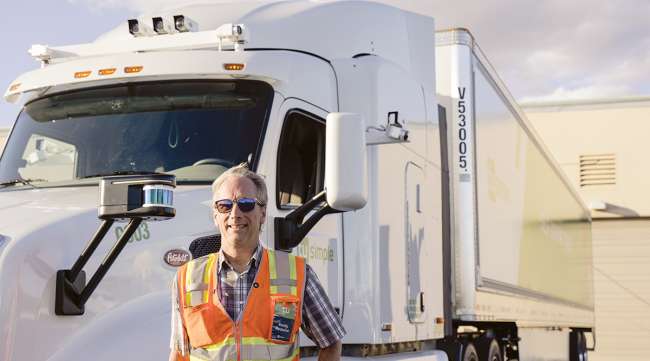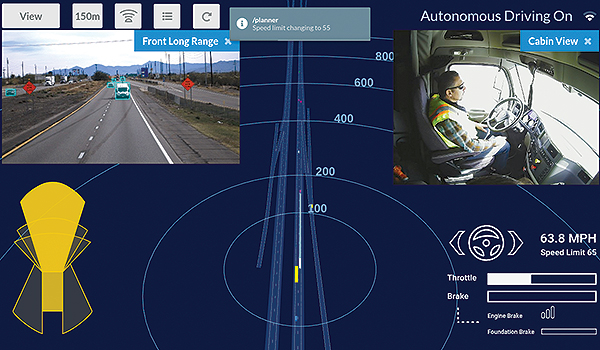Driver Training, Monitoring Could Help Ensure Safe Testing, Deployment of Automated Trucks

[Stay on top of transportation news: Get TTNews in your inbox.]
Self-driving truck developers are putting a growing number of test vehicles on the road to refine their automated driving systems and pave the way for the commercial introduction of this technology.
And as the number of test trucks increases, so, too, will demand for experienced and knowledgeable drivers to monitor these research vehicles as they travel down the highway.
TuSimple, for one, has been testing its self-driving technology on about 50 heavy-duty trucks with the help of teams of specially trained drivers and safety engineers.
As the company works to fully realize its plans to develop a production-ready system in the next few years, it anticipates that transportation companies will be looking to hire drivers with autonomous vehicle training and experience, said Robert Brown, TuSimple’s head of government relations and public affairs.
Leaving nothing to chance, TuSimple recognizes that to continue to develop self-driving vehicles for the trucking industry successfully, certified autonomous truck drivers and operations specialists will be needed, Brown said.
That’s why TuSimple partnered with Pima Community College in Tucson, Ariz., to launch a unique autonomous-driving certificate program.

Missy Blair, a program manager and instructor at Pima Community College in Tucson, Ariz., discusses PCC's partnership with TuSimple. (Bryce Morthland/Pima Community College)
“We recognize that we’re offering a training course for jobs that may not exist at this time, but with TuSimple and others offering preferred hiring status for program graduates, there are significant opportunities,” said Missy Blair, a program manager and instructor at the school.
The 12 credits’ worth of coursework required for the advanced multidisciplinary program could be completed in one semester, Blair said. However, not many drivers can take unpaid time off for several weeks to complete a full-time load of classes. Most drivers meeting the prerequisite three years of driving experience find they have to keep working and complete the program in two semesters, she said.

Fourth Quarter iTECH
- A Witness in the Cab
- Some Fleets Reluctant to Add Driver-Facing Cameras
- Analysis of Onboard Video Can Yield Operational Insights
- Self-Driving Trucks and Presidential Politics
- Driver Training, Monitoring Could Help Ensure Safe Testing, Deployment of Automated Trucks
- In-Cab Monitoring Uses Machine Vision to Detect Fatigued, Distracted Driving
In fact, the program’s first enrollees, who began in August, are expected to complete their training early next year. The program will start again with a new team of enrollees in the spring of 2020.
TuSimple is developing a Level 4 automated driving system, which means the technology can automatically steer, brake, accelerate and monitor the vehicle’s environment without relying on a human driver for backup assistance, at least under certain conditions.
Vehicles at Level 3, or conditional automation, can monitor their environment and make autonomous decisions based on input from sensors, but still require the driver to be ready to intervene if necessary.
In fact, perhaps the most complex and potentially most troublesome concerns over automated vehicles occur at Level 3, during the handover from self-driving systems to human drivers. According to a market analysis completed by Gartner analyst Jonathan Davenport, Level 3 automated vehicles must be able to support safe and efficient handovers between the vehicle and a driver when a vehicle encounters a situation that it can no longer handle on its own.
To accomplish a safe handover and accurately forecast the time needed for doing so, Davenport recommended that developers of Level 3 systems should gather data from a driver-monitoring system to understand the driver’s activity and associated concentration levels while the vehicle is operating autonomously to ensure an appropriate period of time for the handover.

TuSimple's automated trucks have specially trained drivers behind the wheel as they log miles and deliver freight. (TuSimple)
One such system is Seeing Machines’ Guardian driver-monitoring system, which the company said can ensure that backup drivers in self-driving vehicles are alert and ready to take control at any time.
As a growing number of technology firms and fleet operators deploy automated research fleets, the National Transportation Safety Board has recommended the installation of driver monitoring systems to enhance safety and minimize accidents related to fatigue, dwindling attention or distraction on the part of the backup driver.
“It is essential that all drivers understand both the capabilities and the limitations of these technologies at their disposal,” said Ognen Stojanovski, co-founder and chief operating officer of Pronto.ai, which is developing an automated driver-assistance system. “As trucks steadily become more advanced and automated, this kind of safety philosophy and training will be an even more critical component of delivering on the promise of safe driving technologies.”
Want more news? Listen to today's daily briefing:




